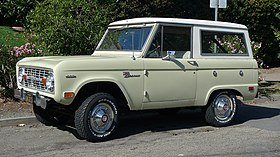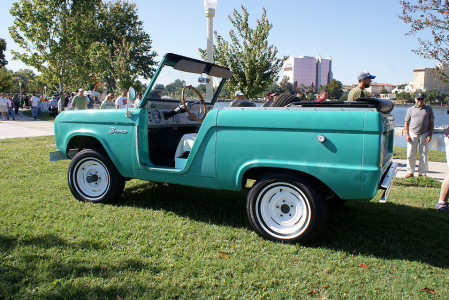

The idea behind the Bronco began with Ford product manager Donald N. Frey in the early 1960s (who also conceived the Ford Mustang) and was engineered by Paul G. Axelrad, with Lee Iacocca approving the final model for production in February 1964, after the first clay models were built in mid-1963. Developed as an off-road vehicle (ORV), the Bronco was intended as a competitor for the Jeep CJ-5, International Harvester Scout and Toyota Land Cruiser. Today a compact SUV in terms of size, Ford marketing shows a very early example of promoting a civilian off-roader as a "Sports Utility" (the two-door pickup version).
Initially selling well, following the introduction of the Chevrolet Blazer, Jeep Cherokee, and International Scout II (from 1969 to 1974), demand shifted towards SUVs with better on-road capability, leading to a decline in demand for the Bronco.
For 1966, three Bronco body configurations were offered, including a two-door wagon, a half-cab pickup, and an open-body roadster. With a base price of $2,194 ($20,055 in 2022 dollars), the Bronco included few amenities as standard. However, a large number of options were offered through both Ford and its dealers, including front bucket seats, a rear bench seat, a tachometer, and a CB radio, as well as functional items such as a tow bar, an auxiliary gas tank, a power take-off, a snowplow, a winch, and a posthole digger. Aftermarket accessories included campers, overdrive units, and the usual array of wheels, tires, chassis, and engine parts for increased performance.
For 1967, Ford introduced the Sport option package for the Bronco wagon. Consisting primarily of chrome exterior trim and wheel covers, the Sport package was distinguished by red-painted "FORD" grille lettering. For 1970, the Bronco Sport became a freestanding model rather than an option package.
To comply with federal regulations, the Bronco was fitted with back-up lights and side marker lamps in 1967 and 1968, respectively. After struggling with sales, the open-body Bronco roadster was withdrawn after the 1968 model year.
After 1972, the Bronco half-cab was withdrawn; along with its lower sales compared to the wagon, Ford had introduced the larger Ford Courier compact pickup.
In a minor revision, for 1977, the exterior-mounted fuel tank caps were replaced behind hinged doors (as on all other Ford trucks).[

